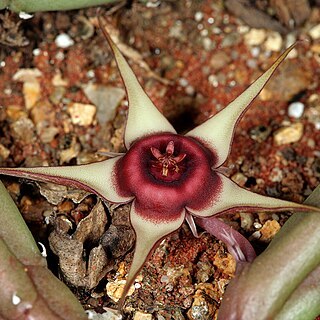Small succulent forming prostrate mats up to 500 mm diam. Stems 60-500 mm long, 7-12 mm thick, prostrate (if erect then soon arching back to soil) sometimes becoming pendent from rocks, green to purplish; tubercles very obtuse and hardly rising out of stem, joined into 5 obtuse angles along stem, each bearing spreading lanceolate leaf-rudiment 2-3 mm long at apex. Inflorescence of 1-5 flowers developing in gradual succession from peduncle (up to 15 mm long), with several slender bracts 2-4 mm long; pedicel 10-15 mm long, 1.5 mm thick, spreading with erect apex holding flower facing upwards; sepals 8-11 mm long, 1.5 mm broad at base, narrowly attenuate. Corolla 30-55 mm diam. when rotate to with lobes fully reflexed (then 8-15 mm diam.); outside smooth, pink mottled on cream to uniformly pale pink with 1 raised longitudinal vein running down centre of each lobe; inside cream on lobes becoming pink to maroon near and on annulus, with very fine red spike-like papillae on lobes (where longest) and often on annulus; tube ±1 mm deep, bowl-shaped, with corolla strongly reflexed below bases of lobes around mouth to form apparent annulus; lobes 13-24 mm long, 4-5 mm broad at base, spreading to reflexed, narrowly lanceolate, acuminate, convex towards base and concave towards apex, with red margins. Corona 2.5-3.0 mm tall, 3.5 mm broad, pink to pale maroon, very slightly raised on minute stipe; outer lobes 0.5 mm long, broadly obtuse, spreading and filling up base of tube; inner lobes <0.5 mm long, adpressed to backs of anthers and shorter than them, dorsiventrally flattened, obtuse, with large obtuse ascending to erect dorsal projection ±1.5 mm long flattened above and with rear extending down to level of outer lobes.
More
Procumbent succulent perennial herb. Corolla lobes pubescent, attenuate; sepals much exceeding sinuses; with prominent raised annulus. Inner corona lobes shorter than anthers, with greatly enlarged dorsal gibbosity forming a spreading or suberect prominent dorsal lobe, inner portion much reduced, closely incumbent on anthers. Flowers cream or putty-coloured, red-margined; corona and annulus maroon.

